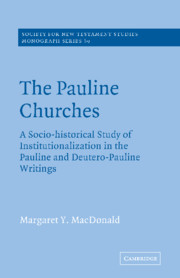 The Pauline Churches
The Pauline Churches Published online by Cambridge University Press: 10 December 2009
The preceding study of development in the communities of Colossians and Ephesians was undertaken in order to trace the process of institutionalization in the Pauline movement which continued in the absence of the Apostle. It illustrated that communal norms, leadership structures, ritual forms, and beliefs were affected by the realities experienced in the sect on account of the death of its central leader. During Paul's lifetime, a symbolic universe had been forming. The disappearance of Paul did not mean the disappearance of the Pauline symbolic universe. Close associates believed in the Pauline mission and sought to continue the work of their teacher. Communities continued to depend on the authoritative voice of the Apostle. In the attempt to bring Pauline teaching to new situations, the Pauline symbolic universe was transformed. Beliefs became detached from their original settings and were made to fit their new social settings. The symbolic universe gained a new objectivity as it passed into the hands of a new generation. Some aspects of the symbolic universe, such as the faith in Christ/works of the law contrast, faded almost completely from view. Other aspects, such as the heavenly enthronement of Christ and the notion of the body of Christ, gained new relevance.
In the earliest days of community-building institutionalization, much ambiguity surrounded the question of how members should act and what they should believe. The authors of the deutero-Pauline writings of Colossians and Ephesians, however, were in possession of many traditions to guide their teaching.
To save this book to your Kindle, first ensure [email protected] is added to your Approved Personal Document E-mail List under your Personal Document Settings on the Manage Your Content and Devices page of your Amazon account. Then enter the ‘name’ part of your Kindle email address below. Find out more about saving to your Kindle.
Note you can select to save to either the @free.kindle.com or @kindle.com variations. ‘@free.kindle.com’ emails are free but can only be saved to your device when it is connected to wi-fi. ‘@kindle.com’ emails can be delivered even when you are not connected to wi-fi, but note that service fees apply.
Find out more about the Kindle Personal Document Service.
To save content items to your account, please confirm that you agree to abide by our usage policies. If this is the first time you use this feature, you will be asked to authorise Cambridge Core to connect with your account. Find out more about saving content to Dropbox.
To save content items to your account, please confirm that you agree to abide by our usage policies. If this is the first time you use this feature, you will be asked to authorise Cambridge Core to connect with your account. Find out more about saving content to Google Drive.